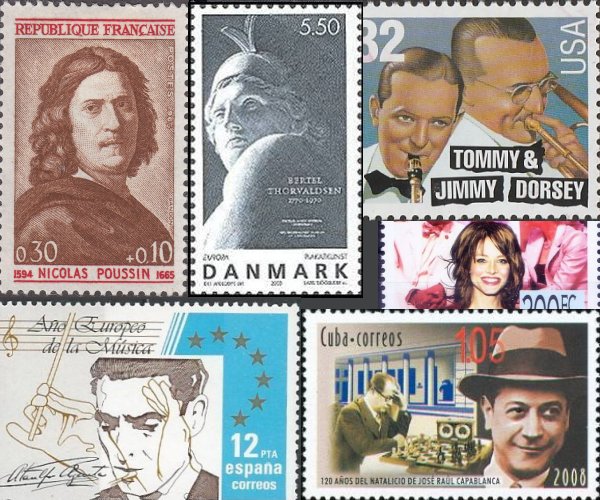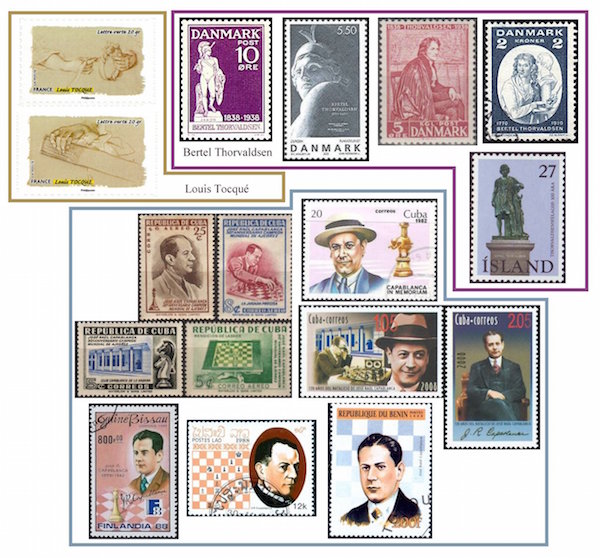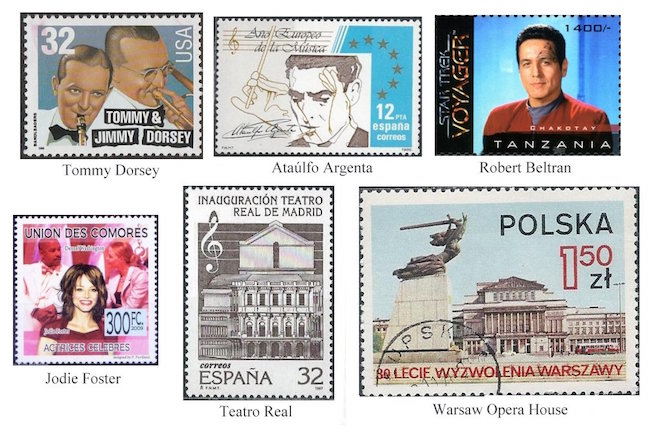The Arts on Stamps of the World — November 19
An Arts Fuse regular feature: the arts on stamps of the world.

By Doug Briscoe
French painter Nicolas Poussin died on this date 352 years ago. Today’s birthday honorees include Tommy Dorsey, Jodie Foster, and the great chess master José Raúl Capablanca. These four, plus another four birthdays and two anniversaries of opera house openings, make up our program.

Born, it is attested, in Normandy, Nicolas Poussin (June 1594 – 19 November 1665) went around 1612 to Paris at a time when there was a demand for new art from both royalty and merchants. He is recorded as having made two attempts to visit Rome between 1617 and 1622, but for reasons unclear turned back on both occasions. He finally got there in the company of the Archbishop of Paris in 1624, and once arrived, remained for sixteen years. He was enticed back to Paris by the promise of handsome commissions, but on his return found that there were rather too many to handle, and he found court intrigues distasteful, so after just a couple of years he packed up and returned to Rome. Poussin’s output consists mainly of mythological and religious works, with a smattering of landscapes and no portraits to speak of except the ones he made of himself. We begin with French and Russian stamps that show his Self-Portrait of 1650. Two stamps taken from a large Poussin sheet issued by Saint Vincent and the Grenadines offer a segmented look at Et in Arcadio Ego (The Shepherds of Arcadia, late 1630s). Two stamps showing art in Russian museums provide us with a view of Tancred and Arminia (1631) and Landscape with Polyphemus (1649). (You may have to look carefully to see the cyclops playing the flute atop the mountain peak at right.) The stamp from Djibouti has Nymph, Faun, and Putti (Nymphe chevauchant un bouc ou Vénus, faune et putti, c1631), and we move to the third row for a detail from The Destruction of the Temple in Jerusalem (1638, on a stamp from Paraguay) and one from Adoration of the Shepherds (1633-34) on a Christmas stamp from Niue. (The cluster of putti at the top—unseen on the stamp—once featured on the cover of an old London Stereo Treasury Series LP of Karl Münchinger’s first recording of the Bach Musical Offering. I’ve been wondering what that picture was ever since I purchased the album about forty-five years ago.) Another pair from the Saint Vincent sheet shows The Inspiration of the Poet (1639). At the very bottom of the collage is a French stamp that reproduces the drawing Moses Defending the Daughters of Jethro, kept at the Louvre.
We have another French painter next, but one born a century after Poussin. Louis Tocqué (19 November 1696 – 10 February 1772) was the son of a painter and, in sharp contrast to Poussin, concentrated almost exclusively on portraits. His career was established when he made one of the future Louis XV. The only Tocqué stamps I could locate are a pair from a 2015 set devoted to details of paintings representing the sense of touch. These images of gestures of the hands show two pieces attributed to Tocqué, but I was unable to identify either.
Just like Nicolas Poussin, Danish sculptor Bertel Thorvaldsen (19 November 1770 – 24 March 1844) spent the greater part of his life (1797–1838) in Italy, but unlike him, lived his final years in his homeland. He was born in born in Copenhagen to an Icelandic woodcarver who made figureheads and did other piece work for ships. Thorvaldsen’s education was not so thorough, but with help he got into the Royal Danish Academy of Art when he was only eleven. At night he helped his father woodcarving. His work at the academy was so fine that he was granted a royal stipend and set off for Rome. Made it on the first try, too. One of the first pieces he executed there (see below) was warmly praised by Antonio Canova. He was just about to return to Denmark when he received a commission that not only made it possible for Thorvaldsen to stay, but was so well received that it allowed him to stay for another 35 years. (He did make a journey home in 1819.) When he came home for good in 1838, it was to a hero’s welcome. The last meal he enjoyed before his fatal heart attack was shared with his friends Adam Oehlenschläger and Hans Christian Andersen. On two Danish stamps we see the same work from different angles—it is that early masterpiece that made Thorvaldsen’s name in Rome: Jason with the Golden Fleece. Another renders Christoffer Wilhelm Eckersberg’s portrait of Thorvaldsen. A fourth Danish stamp is for his bicentennial. The Icelandic stamp celebrates the centenary in 1975 of the Bertel Thorvaldsen Society. It shows the artist’s self portrait of 1839, although this bronze copy of the marble original, made in 1894, actually stands in New York’s Central Park. He is seen resting his arm on one of his other works, the Goddess of Hope. One of the artist’s most famous pieces is the lion monument in Lucerne in honor of the Swiss Guards, which he carved in 1819. I thought it might appear on a Swiss stamp, but I guess not.

Considered one of the greatest chess players in history, José Raúl Capablanca (19 November 1888 – 8 March 1942), born in Havana, defeated a champion two days before turning 13. He entered Columbia University in 1905 but stayed only a single semester before leaving and devoting himself exclusively to chess. He was undefeated from 1916 to 1924 and wrested the world championship from Emanuel Lasker in 1921, retaining the title until 1927. Capablanca’s book Chess Fundamentals was praised by Mikhail Botvinnik as the best book ever written on the subject. He suffered from extreme hypertension and died at 53. Capablanca was honored on stamps as early as 1951 on the occasion of the 30th anniversary of his world championship win. Cuba remembered him again in 1982 and 2008, and there are also stamps from Guinea-Bissau, Laos, and Benin.
It’s Tommy Dorsey’s birthday today. Earlier this year we mentioned his brother Jimmy only in passing on account of his being a Leap Year baby. Thomas Francis Dorsey Jr. (November 19, 1905 – November 26, 1956) was the younger of the two and played together with Jimmy until their rancorous split in 1935. They were born in Pennsylvania to a bandleader and had their first hit in 1929 with “Coquette”. After they formed separate bands, Tommy Dorsey made many recordings with Frank Sinatra (who credited Tommy’s trombone playing with teaching him about breath control) and included such players as Nelson Riddle and Doc Severinsen in his band. Tommy broke up his orchestra in 1946 but started a new one the next year. When Jimmy’s band dispersed in 1953, Tommy invited his brother to reunite, and the band was henceforth known as the Tommy Dorsey Orchestra featuring Jimmy Dorsey. Tommy died of asphyxia resulting from oversedation with sleeping pills. Jimmy took over the band until he died from lung cancer the next year.
Today is the birthday of Spanish conductor and pianist Ataúlfo Argenta (November 19, 1913 – January 20, 1958). Argenta first conducted publicly in 1934. He served in a communications battalion on the side of the Nationalists during the Spanish Civil War. He furthered his studies in Germany in 1941 and led the Berlin Radio Orchestra in May 1942. Argenta and his family returned to Spain after their home was destroyed in an Allied bombing. He conducted the Spanish National Orchestra and made the first commercial recording of Rodrigo’s Concierto de Aranjuez with the work’s dedicatee Regino Sainz de la Maza. (Rodrigo’s birthday is in three days.) Argenta left many recordings, including more than fifty of complete zarzuelas.
We have next two American actors both born in Los Angeles exactly nine years apart. Robert Beltran (born November 19, 1953), child of Mexican immigrants, first hit the big time with his role in Paul Bartel’s black comedy Eating Raoul (1982). Though he had regular work in television, on film, and on the stage since 1979, his best known character was Commander Chakotay on Star Trek: Voyager (1995-2001; see the stamp). More recently he’s been seen in a recurring role on the hit HBO series Big Love. One of his nine siblings is the Latin Jazz musician Louie Cruz Beltran.
Our other Angelino (Angelina, actually) has had a much higher profile. I speak of Alicia Christian Foster (born 1962), who since childhood has been known as Jodie Foster. A descendant of a passenger on the Mayflower, Foster learned French at an early age (she usually dubs her own voice for French-language versions of her films and has acted in a few French ones). She is also fairly conversant with Italian, Spanish, and German. She went to Yale (during which time the John Hinckley episode happened), majored in literature, wrote her thesis on Toni Morrison, and was graduated magna cum laude in 1985.

Twelve years later she earned a Doctor of Fine Arts degree. After a great deal of work in commercials and TV from the age of three or so, Foster first appeared on the big screen in Napoleon and Samantha in 1972. The story involves a lion that misbehaved off screen and got hold of Foster at one point, leaving permanent scars on her back. She had already worked with Martin Scorsese once before when he cast her as the teenage prostitute in Taxi Driver (1976), a performance for which she received a supporting actress Academy Award nomination. She broke into adult roles with The Accused, for which she did win the Best Actress Oscar along with a Golden Globe. Her very next film was the hit The Silence of the Lambs (1991). That same year she took the director’s chair for the first time with Little Man Tate, and then she started her own production company, Egg Pictures (1992-2001). The Jodie Foster stamp from the Comoros shows a still from Inside Man (2006) with Denzel Washington. I would also recommend, if you haven’t seen it, Roman Polanski’s Carnage (2011) with John C. Reilly, Kate Winslet, and Christoph Waltz. Since 2014, Foster has been married to actress and photographer Alex Hedison, the daughter of actor David Hedison (remember the original version of The Fly and the TV series Voyage to the Bottom of the Sea?).
As I mentioned at the outset, today marks the anniversaries of the openings of two opera houses. The Teatro Real in Madrid, although founded as early as 1818, did not have its own proper home until decades later. The opera house was established on 19 November 1850. As a consequence of work on the subway system, the foundation was weakened, and the building was closed to the public from 1925 to 1966, when it reopened as a concert hall. It was not functional as an opera house again until 1997, in which year it was commemorated on a Spanish stamp.
Today is also the 52nd anniversary of the reopening of the Warsaw Opera House. From their homepage: “The Teatr Wielki was erected in 1825–33, according to a design by Antonio Corazzi. It was then reconstructed several times. During the 1939 seige [sic] of Warsaw it was bombarded and almost completely destroyed. In 1945–65 the company performed on other stages while the buiding [sic] was being rebuilt from rubble and extended. The new, larger and more modern opera house was opened on 19 November 1965.”
A graduate of the University of Massachusetts with a B.A. in English, Doug Briscoe worked in Boston classical music radio, at WCRB, WGBH, and WBUR, for about 25 years, beginning in 1977. He has the curious distinction of having succeeded Robert J. Lurtsema twice, first as host of WGBH’s weekday morning classical music program in 1993, then as host of the weekend program when Robert J.’s health failed in 2000. Doug also wrote liner notes for several of the late Gunther Schuller’s GM Recordings releases as well as program notes for the Boston Classical Orchestra. For the past few years he’s been posting a Facebook “blog” of classical music on stamps of the world, which has now been expanded to encompass all the arts for The Arts Fuse.
